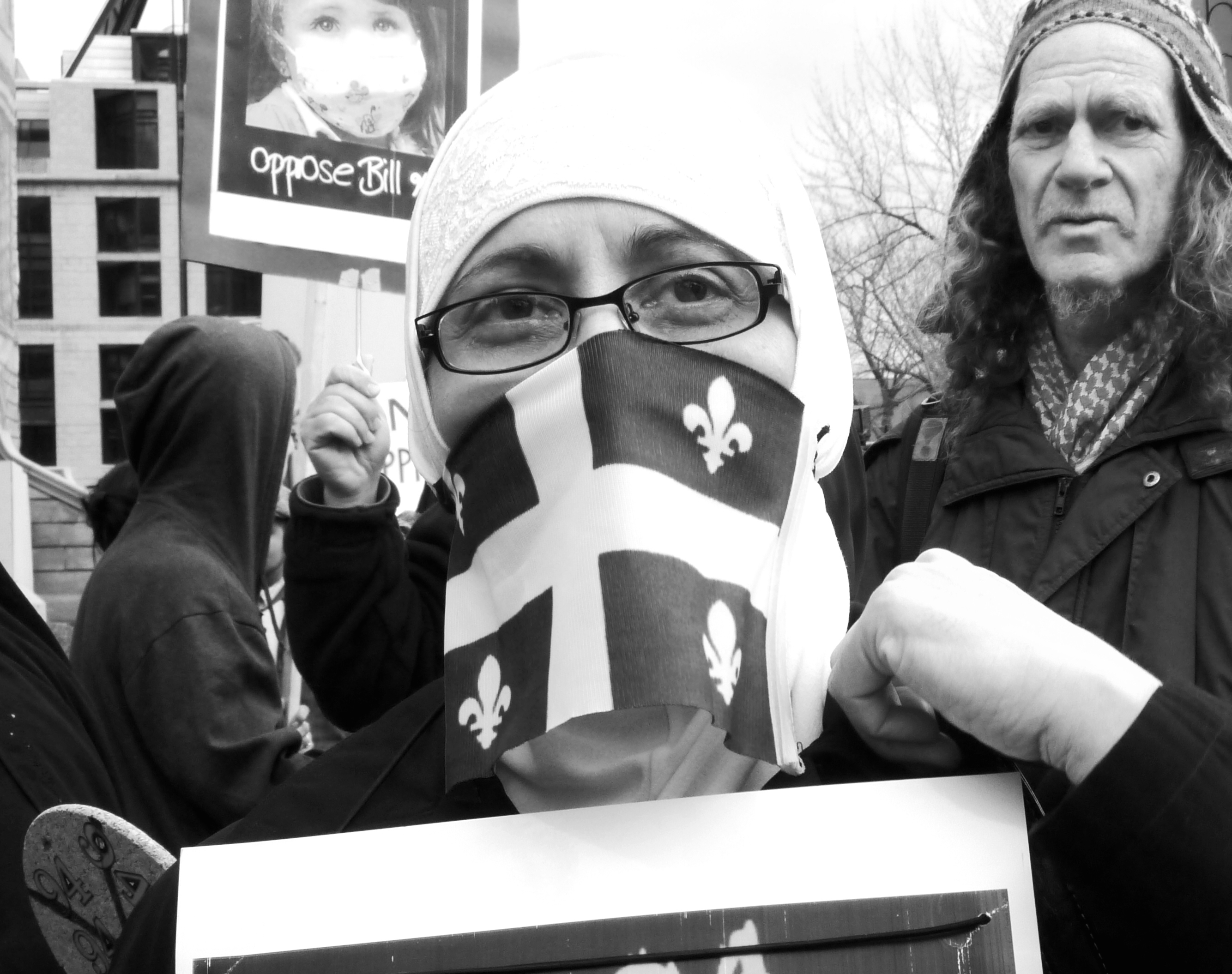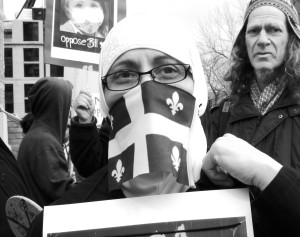Niqab Bans: 21st Century Islamophobia or Harper Election Distraction?
 Protester of Bill 94, a defeated bill in Québec that would have mandated women to uncover their faces before receiving public services. Credit: scottmontreal, Flickr Community Commons. Cropped.
Protester of Bill 94, a defeated bill in Québec that would have mandated women to uncover their faces before receiving public services. Credit: scottmontreal, Flickr Community Commons. Cropped.

Over this past Thanksgiving weekend, Canada saw 3.6 million Canadians go to the ballots to cast their early votes.1 Out of those 3.6 million, a select few headed to the polls wearing clown masks, ski masks, or potato sacks over their faces. This bold fashion statement was a reaction to a debate that has engulfed public discourse during this year’s 42nd federal election. The controversial question that has been discussed is whether or not a new citizen can wear a niqab, or face veil, to a citizenship ceremony.
Instead of justifying the rights of a woman to wear what she wants, I’d rather focus on understanding how such a non-starter issue has risen to affect the current election in a pivotal way. For instance, the NDP’s policy on the niqab at citizenship ceremonies — namely that women do not need to uncover their faces — has been used to explain the party’s recent skydive in the polls nationwide. Mulcair has also been losing his stronghold in Québec, which can be explained through a recent Privy Council survey that showed that 93% of polled Quebecers (compared to 82% of Canadians as a whole) said that they support such a ban.2
In a country that prides — or arguably used to pride — itself on multiculturalism and the upholding of basic rights and freedoms, a debate centered on intolerance seems baffling.
Why has the issue of whether or not a new citizen can wear a face veil at a citizenship ceremony all of sudden blown up? Why are previously unchallengeable rights, such as freedom of religion and freedom of expression, outlined in Section 2 of the Charter of Rights and Freedoms, being called into question? The answer lies in recent progressions of xenophobia and Islamophobia.
A simple explanation for this recent change entails pointing a finger at Stephen Harper. His methods range from the prioritization of non-Muslim incoming Syrian refugees3 to leading a fear-mongering campaign with the infamous Bill C-51. Moreover, Harper has used events such as the Ottawa and Saint-Jean-sur-Richelieu attacks to instill a fear of “otherness” in the Canadian population. His galvanizing rhetoric only intensified when he called an election in August. Announcing the start of the campaign so early was an attempt to ride the wave of public opinion regarding the niqab to another term at the PMO. Mr. Harper is seeking a renewed mandate to police the fundamental rights of Canadians. He has even proposed a “tip line” to report suspicious neighbors who might be performing “barbaric practices”,4 in addition to supporting a measure to look into banning public employees from wearing niqabs and similar religious face coverings.5
On a macro level, the Canadian public opinion and Mr. Harper’s actions stem from global trends that have been penetrating Canada since the end of the 20th century. These trends of growing Islamophobia and xenophobia in the post-9/11 world serve to explain the current political culture in Canada and elsewhere. Furthermore, they reinforce the problematic and dangerous side of using such rhetoric to win an election.
Certain events that have preoccupied the news for most of Millennials’ lives have overshadowed the underlying phenomena that accompanied these occurrences. Terrorist attacks before and after the 1993 World Trade Center bombing have made the front page — and rightfully so. However, often hidden from the public eye, especially in American media, are the repercussions that minorities, particularly Muslims, have faced in the aftermath of such attacks. The exclusion of minorities’ situations in the media has been exacerbated by an escalation of tensions between the secular West and Islam. The latter is apparent in the political and social attitudes of countries towards Islam. In the United States, the PATRIOT Act following 9/11 overstepped federal power and harmed many Muslim Americans, while in France, a law banning face covering in public was enforced in response to increased migration from Muslim countries. The West has also seen a rise in hate crimes and intolerant attitudes towards refugees fleeing the Syrian civil war.
The increased attention paid to topics such as al-Qaeda, the Arab Spring, Bashar Al-Assad’s oppression, the Charlie Hebdo attacks, the rise of ISIS, and the Syrian refugee crisis has brought to the forefront the debate of Islam’s place in the Western world. Along with the debate came the predominance of Islamophobic and xenophobic voices from politicians. For example, some European states have closed their borders to stop the flow of Syrian refugees, the French extreme right-wing party, Front National, has threatened to shut down mosques and deport Islamic religious leaders,6 and Donald Trump has said that he will be looking into how to “get rid” of Muslims.7 The general trend of states is a move towards closed borders and increased suspicion of people practicing Islam. These fears, legitimate or not, have manifested themselves in legislation and public attitudes in Western countries. In Canada, Mr. Harper and the Conservative party have capitalized on this global trend and employed these fears to gain support in the polls.
The use of Islamophobia and xenophobia to garner electoral support is a danger to Canada and to democracy. The global political and social trend to brand every Muslim as a threat based on the actions of extremist groups undermines individuals’ basic rights and freedoms. It is in breach of the Canadian Charter of Rights and Freedoms, of the First Amendment, and of international conventions that uphold people’s rights to religion and freedom of expression.
Beyond overstepping laws protecting people’s freedoms, the current attitudes of xenophobia and Islamophobia undo the social fabric of democracies like Canada. The marginalization of certain minority groups and the scapegoating of those who “look different” reverse the purported values of multiculturalism and acceptance that many Canadians still hold dear. Despite the focus on the intolerant views of a section of the Canadian public, some have chosen to stand up against xenophobic fears. These Canadians opposed La Charte des valeurs québécoises. They have also spoken up in the current debate and have pointed out that a woman’s choice to cover her face during a citizenship ceremony is not an issue that should define citizens’ vote choices. However, these Canadians are in the minority during this year’s election.
In a world where social and cultural turmoil have descended into violent conflict, the last thing we need is increased xenophobia on Canadian soil. Mr. Harper’s Islamophobic policies, provoked by tragic world events, have created an atmosphere of hate at a time when Canada requires cohesiveness. Taking an originally non-starter issue and inflating its importance during an election period is just one more way Mr. Harper has prioritized political power over the good of his country.
The current debate over the niqab’s presence in citizenship ceremonies is merely a manifestation of an incumbent prime minister’s political strategy. He has used a geopolitical trend to ride a wave of xenophobic support to government in Ottawa. As for a more convincing response to the niqab debate, Liberal leader Justin Trudeau’s comment in March of this year ties up the controversy neatly. He states that, “You can dislike the niqab. You can hold it up [as] a symbol of oppression. You can try to convince your fellow citizens that it is a choice they ought not to make. This is a free country. Those are your rights. But… it is a cruel joke to claim you are liberating people from oppression by dictating in law what they can and cannot wear.”8
[1] http://www.elections.ca/content.aspx?section=med&document=oct1415&dir=pre&lang=e
[2] http://www.torontosun.com/2015/09/24/polling-data-on-niqabs-shows-82-of-canadians-support-ban
[3] http://www.nytimes.com/2015/10/16/opinion/with-anti-muslim-campaign-canada-has-its-trump-moment.html?action=click&pgtype=Homepage&module=opinion-c-col-right-region®ion=opinion-c-col-right-region&WT.nav=opinion-c-col-right-region&_r=0
[4] https://news.vice.com/article/conservatives-in-canada-want-to-set-up-a-snitch-line-for-barbaric-cultural-practices
[5] http://www.nytimes.com/2015/10/16/opinion/with-anti-muslim-campaign-canada-has-its-trump-moment.html?action=click&pgtype=Homepage&module=opinion-c-col-right-region®ion=opinion-c-col-right-region&WT.nav=opinion-c-col-right-region&_r=0
[6] https://www.washingtonpost.com/world/europe/french-muslims-caught-between-rising-islamophobia-and-growing-extremism/2015/03/22/7359329c-c739-11e4-bea5-b893e7ac3fb3_story.html
[7] http://www.salon.com/2015/09/18/donald_trump_were_going_to_be_looking_at_how_to_get_rid_of_muslims_and_foreigners_like_obama/
[8] http://www.macleans.ca/politics/for-the-record-justin-trudeau-on-liberty-and-the-niqab/
